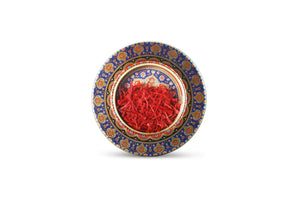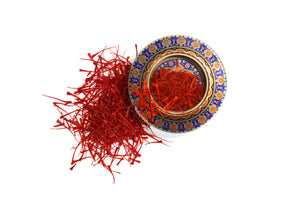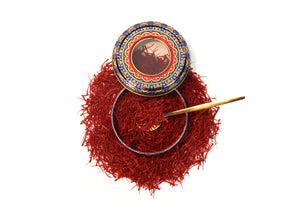Saffron is the delicate red stigma from the Crocus sativus flower. It’s hand-picked, intensely aromatic, and used in tiny amounts for colour, aroma and a gentle lift in flavour. This guide covers the essentials so you can start confidently.
What is saffron and why is it so prized?
Saffron threads are the dried stigmas of a purple crocus. Each flower yields only three threads, which must be harvested by hand and dried with care - one reason saffron is considered the world’s most precious spice. Good saffron looks deep crimson, smells honeyed and slightly hay-like, and turns liquids a warm golden hue. Threads (whole stigmas) are preferred for purity and freshness; ground saffron is convenient but easier to adulterate.

What does saffron add - flavour, colour and potential benefits?
Saffron brings a rounded, aromatic flavour: softly floral, a little honeyed, with a clean bitterness that balances sweet or rich dishes. It adds natural golden colour without overpowering other ingredients.
Nutritionally, saffron contains compounds such as crocin and safranal that contribute to its colour and aroma. Early research suggests saffron may support mood and calmness, but evidence is still developing. Enjoy it primarily as a culinary spice; any wellness effects are a possible bonus.
How do I use saffron at home?
The simplest method is to “bloom” saffron before adding it to your recipe.
Basic bloom (for 2–4 servings)
-
Lightly crush 10–20 threads with a spoon.
-
Add 2–3 tbsp warm water, milk, or stock (not boiling).
-
Steep 10–15 minutes; the liquid turns deep yellow-gold.
-
Add the liquid and threads to your dish.
Quick ideas
-
Rice & grains: Bloom 0.1–0.2 g saffron for a pot serving 3–4. Stir in at the simmer stage for even colour.
-
Tea/latte: Bloom 5–10 threads in hot water or warm milk with honey; add cardamom or cinnamon if you like.
-
Desserts: Infuse cream or milk for custards, panna cotta or ice-cream. Start light; saffron strengthens as it infuses.
-
Savory dishes: Add to seafood stews, chicken braises, or vegetable soups for aroma and balance.

Buying & storage
-
Choose vivid, uniformly red threads with minimal yellow. A fresh, sweet-hay aroma is a good sign.
-
Store in an airtight jar, away from light, heat and moisture. Best within 12–18 months for peak aroma.
Pairing tips
Saffron loves: basmati rice, citrus, honey, dairy, tomatoes, seafood, chicken, pistachio, almond, rose, cardamom and cinnamon.
Safety & Common Sense Notes
-
Culinary amounts are generally considered fine for most adults. More isn’t better - saffron is potent in both flavour and colour.
-
If you’re pregnant, breastfeeding, have a medical condition, or take medication (especially for mood), seek professional advice before using large or supplemental amounts.
-
Avoid products that seem unusually cheap; quality saffron is labour-intensive.
Saffron is a hand-harvested spice that adds golden colour and a distinctive, aromatic flavour to sweet and savoury dishes. Start with a small bloom, taste as you go, and build from there. If you’d like to explore a carefully selected saffron, you’re welcome to discover Seko Street’s range.





0 comments